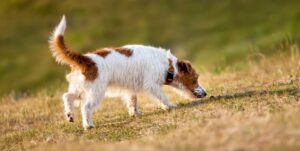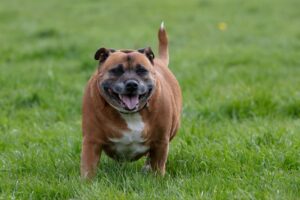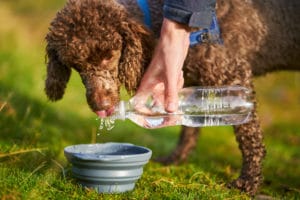As many people know, the obesity epidemic in America doesn’t just affect humans; it extends to our canine companions as well. A 2015 study showed that 52.7% of dogs in the U.S are obese! This statistic is frightening, as obesity in dogs brings with it a whole host of problems like joint damage and immobility issues.
Even with these potential problems, many Pack Leaders still struggle with determining how to get a dog to lose weight. What’s the best routine? What changes need to be made?
We will walk through these answers, teach you how to get your dog back in shape, and enjoy the journey with them!
What Are The Health Risks With Dog Obesity?
There are numerous health concerns that can get worse with the level of your dog’s obesity.
Joint Health
Some of the most common problems seen in overweight dogs include some type of joint pain or issues with immobility. This is because the unnecessary weight puts a lot of stress on your dog’s joints, and they are not used to carrying that much.
Pain in their joints could lead to more severe problems in the future, like arthritis or hip displacement.
More Prone To Internal Diseases
Unfortunately, canine obesity has also been tied to various internal health problems in dogs, from pancreatitis and diabetes to heart disease and hyperextension. That isn’t all; obesity has even been proven to increase the risk of cancer and can reduce a dog’s life expectancy by one to two years!
However, just like humans, every dog is different. While some may be subject to certain health risks, not all will have the same issues.
Either way, shedding some extra pounds can go a long way toward helping your pup lead a healthier, happier, and longer life.
How To Know If Your Dog Is Overweight?
Talk With Your Veterinarian
Discussing with your veterinarian should always be your first step. Chat with them and find out just how much weight your dog needs to lose as well as any special precautions you should take to protect their health as you start your new routine.
Your dog’s breed, medical history, and current state are all important factors to consider. Your vet should help walk you through what weight your dog should ideally be at and make recommendations based on their needs.
Feel Their Rib Coverage
Rib coverage is also a necessary measure you can take to determine whether your dog is overweight, and it’s easy to do on your own! All you have to do is feel down his rib cage from the top of his shoulders to the bottom and make sure you can feel them.
You should be able to feel each of your dog’s ribs with minimal padding around it, especially at their tips. If you can’t find any when you press down on them, they may be overweight!
Know Their Ideal Body Weight
The next step is to learn your dog’s ideal body weight. Determining this will also require some help from your veterinarian, as there is no one set scale you can go by. The perfect weight will change depending on their breed, age, and health status.
Your vet should be able to give you a score based on their body condition and what their ideal weight should be. From here, you should work toward this goal and track their progress.
How Can I Help My Dog Lose Weight?
The best way to help your dog with their weight loss journey is by committing and showing him that you’re on his side. Do not rush the weight loss process; start slow and work up from there.
Dieting
It would be best if you started by altering their diet to feature low-fat proteins and simple carbs.
Try using a specific nutritional product, a specific portion, and a particular meal frequency. Don’t guess. Don’t eyeball it. Give your dog precisely the amount of food they need every day. Read the recommended amount on the bag of food and stick to it.
Simply reducing the amount of food they’re getting could lead to malnourishment down the road.
There are also various dog foods designed for weight management on the market, and your veterinarian can help you choose the best one for your pet.
Tip to Remember: Your dog should always have access to fresh, clean water — no matter the time of day or night.
Exercise is Key
This may seem like a no-brainer, but exercise is a primary key to any weight loss plan. Getting your dog outside and doing some of their favorite activities will help support the change in their nutrition plan and can go a long way.
Walking
Set aside at least 40 minutes each day for a walk. If you’re just starting the routine or your dog isn’t used to exercising at all, you may want to consult with your veterinarian to see if you should start with a shorter time, such as 10 or 15 minutes, and then work your way up.
Walking can be a game-changer for your dog and will allow you to be active together.
Playing
You can also try playing fetch or taking them to the dog park! These games will get their energy out while also allowing them to work on their focus and problem-solving skills.
Mixing in fun activities like this and dedicating time to having fun will keep your dog happy and motivated throughout the process!
Training
You can also help your pup lose weight by training them! Remember, dogs need to work their brain as well as their body. If they have a good understanding of all the basics, such as sit, lay down, come, and stay, they will be more than happy to return the favor with some physical activity for you both.
Training is also an excellent way to build true loyalty and companionship, which is essential for your role as pack leader and the relationship with your dog.
Need Help Training?
Working on training commands will help keep your dog mentally stimulated while they exercise and practice obeying you again and again. It’s a win-win!
If you need more information on properly training your dog or need a professional trainer, visit our training page to view our options and courses!
Reduce Treats and Unneeded Calories
Many dogs get a large portion of their daily calories from treats throughout the day or by sneaking table scraps. If you still want to use treats as motivation for training, check the nutrition and look for small, low-calorie snacks.
Low-Calorie Treats
To prevent obesity, the treats your pup gets should only make up around 10% of their daily calorie intake. To reduce this, try using fresh or frozen green beans, broccoli, and cauliflower, as well as air-popped popcorn as a new type of reward, as long as your veterinarian approves them.
Food Thief
Another common source of unneeded calories is stealing others’ food. It could be grabbing human food when your back is turned or taking food from other animals in the home. You can help prevent these problems by putting your dog in a crate during other family members’ mealtimes or feeding your animals separately from one another.
A Summary of Cesar’s Tips
To build a lasting plan for you and your dog’s weight loss journey and make the process easier, follow these steps:
- Talk to your veterinarian
- Measure your dog’s food
- Set meal times
- Cut out the snacks
- Stop the thieving
- Stick to a walking schedule
What changes do you plan to make (or have you made) for your dog’s daily routine to help her get into shape? Let us know in the comments!











